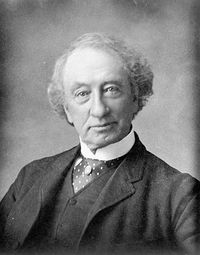 Shall I Bake a Cake? On this day − January 11, 2015 – of Sir John A. Macdonald’s 200th birthday anniversary I want to offer something special, something that may be remembered for the truth that Canada is. The Algonquin of Ontario offer After more than two decades since the Algonquin land claim was first accepted in 1991/2 as valid by the provincial and federal governments, it finally happened: the Algonquin of Ontario (AOO) agreement-in-principle (AIP), also known as a settlement offer, was finally tabled. The Algonquin Anishinaabeg are entitled to a pitiful 1.3% of our traditional territory, which amounts to 117,000 acres and a measly $300 million one-time buyout. Keep in mind here that the Department of Justice’s budget for 2014-15 is $662 million. I can’t and won’t read the AOO AIP. Reading policy, legislation, and legalese is not one of my gifts. There is no point in reading the details anyway. Let’s face it, it is only gaining access to land and resource rights that will lead to the emancipation of the Algonquin Anishinaabeg. I know many Algonquin people who have been, and some remain, both homeless and hungry. I also know many Algonquin Anishinaabe who have suffered, and continue to suffer, from the loss of their cultural meaning field. You can be sure that 1.3% of our traditional land base and $300 million is not going to resolve this suffering and make it go away. Harper, Taiaiake, Ladner, Diabo, and Palmater I am not alone in making this argument about the role of land and resources in Indigenous people’s ability to live a mino-pimadiziwin (good life). Elijah Harper, Alfred Taiaiake, Keria Ladner, Russell Diabo, and Pam Palmater, have argued this as well. We make this argument as we know it is only through land and resources that we will be able to set up meaningful institutions that are rooted in and emerge from our worldview. Honouring Indigenous Rights has Broader Implications It is no mystery that western cultural structures don’t work for us – and for that matter the rest of the natural world such as the water, the trees, the fish, and the birds included. I really need to add here that it should also be clear to everyone by now that the current economic model which lacks a moral code is inadequate for all people: heterosexual able-bodied white men included. Let’s face it, trees clean the air we breathe, and money is simply not nutritious. Yet, for some reason many people continue to think through an “us versus them”, meaning the Indians against the settler Canadians, cognitive model, and in this way they become complicit in their own domination. A Land Claims is Not a Class Action Unfortunately some people, Algonquin Anishinaabeg included, actually view the land claims process as analogous to a class action suit against a corporation such as Loblaws, where a final settlement is all that is required. Actually, these people have been encouraged to think of it through this line of pitiful reasoning. Through this, many people are inclined to think that $300 million is a good deal. Sir John A. Mcdonald, my parents and their children as all Algonquin Anishinaabeg deserve so much more. Resources Extracted To get a better handle on whether this is a good settlement offer one has to ask, as I have, “how does $300 million compare to the dollar amount of resources that have come out of Indigenous land?” Further, I have tossed these numbers around before and some people may be inclined to argue they are old and require updating, but who has the time? In the Indigenous knowledge tradition repetition is valued as an important and significant way of knowing. In 2005, the Ministry of Northern Development and Mines gained $4.8 billion from metals, such as cadmium, cobalt, copper, silver, and zinc from the land in southern Ontario. In the same year, $2.4 billion in non-metals, such as cement, clay products, lime, quartz, salt, soapstone, and stone, was extracted. That is billions of dollars in a single year folks. Remaining closer to Algonquin territory, during 2003 the forestry industry of Algonquin Provincial Park generated $152.8 million toward Ontario’s economy. In 2005, Algonquin Park alone generated $13.5 million from visitors, campers, concessions, and commercial leases. Further, in 1999, the estimated gross value of the hydroelectric energy produced by the Madawaska River system, a tributary of the Ottawa River, was worth about $45 million. In reviewing these numbers, one has to wonder what would these numbers total when considering the last 500 years of colonization? Although I am not sure there is such a thing, it is my guess the total number would be in the mega zillion dollar range. Okay, I admit maybe I am exaggerating here but for goodness sake, the point is Indigenous people have financed the construction of Canada and its settler population, yet benefited little in the process. Canada was built on the backs of Indigenous people. No thanks John A. Macdonald! Acreage Offered In terms of the acreage the Algonquin Anishinaabeg are offered, Algonquin Park consists of 1,891, 097 acres. This is sixteen times larger than the 117,000 acres offered to the Algonquin. There are seventeen provincial parks in Algonquin territory in Ontario. These parks include but are not limited to Silver Lake Provincial Park, Bonnechere Provincial Park, Bon Echo Provincial Park … . Canada, are you getting the idea here? I really hope so. Since the Algonquin land claims process began it has been plagued with racism, sexism, anti-intellectualism, a pitiful hunting interim agreement, faulty election processes, and White interference. Yes, that is right, White interference. When I reflect on this pitiful process it becomes more obvious to me that the land claims process is nothing more than a federal and provincial job creation project, where legal advisors, a few Indigenous people, and the Canadian government benefits at the expense of too many, mostly women and children. As an Algonquin Anishinaabe, Sir John A. Macdonald, I wonder how many good and loyal settler Canadians are set to celebrate the anniversary of your birthday, knowing this history of the country you founded? Rest assured, I won’t be baking a cake. Related Links: http://rabble.ca/news/2013/06/genocide-racism-and-canada-day-algonquin-anishinaabekwe-love-letter http://rabble.ca/news/2013/03/heart-break-algonquin-genocide https://canadiandimension.com/articles/view/canada-is-not-the-arbiter-of-what-is-genocide http://www.lynngehl.com/black-face-blogging/three-of-canadas-genocidal-policies http://anishinabeknews.ca/2014/11/27/algonquin-chiefs-say-tsilhqotin-supreme-court-decision-is-no-more-than-colonial-policy/  Lynn Gehl, Ph.D. is an Algonquin Anishinaabe-kwe from the Ottawa River Valley. She has a section 15 Charter challenge regarding the continued sex discrimination in The Indian Act, and is an outspoken critic of the Ontario Algonquin land claims and self-government process. She has three books: Anishinaabeg Stories: Featuring Petroglyphs, Petrographs, and Wampum Belts, The Truth that Wampum Tells: My Debwewin of the Algonquin Land Claims Process, and Mkadengwe: Sharing Canada's Colonial Process through Black Face Methodology. You can reach her at [email protected] and see more of her work at www.lynngehl.com.
1 Comment
Rob-bear
1/7/2015 01:49:31 am
Message to Sir John A. on his 200th birthday: Bah! Humbug!
Reply
Your comment will be posted after it is approved.
Leave a Reply. |
|
To subscribe to Lynn's Blog: click here
To subscribe to Lynn's Newsletter: click here To follow Lynn on her Public Facebook Page: click here To subscribe to Lynn's YouTube channel: click here To book Lynn as a speaker: click here To contact Lynn/License her work: click here Copyright Dr. Lynn Gehl, 2024 All Rights Reserved
|
 RSS Feed
RSS Feed
